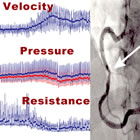|
Stent Decision-Making Using Functional Measurement: Fractional Flow Reserve (FFR) and Instant Wave-Free Ratio™ (iFR®) - What's in a Number?
Presentations at EuroPCR 2012 Enjoy Spirited Debate; Implications for Clinical Practice of Interventional Cardiologists
|
 |
 |
June 12, 2012 -- Preliminary data, presented at this year's EuroPCR meeting, show increasingly that functional measurement is a critical part of the therapeutic decision-making process for cardiologists: whether to stent a blocked coronary artery or instead triage a patient to medical therapy alone. The first results from the FAME II Study were made available and they confirmed that, when Fractional Flow Reserve (FFR) was used to make this decision, the appropriateness of stenting was confirmed soundly. In separate presentations, a new tool for functional measurement was discussed: the technology of Instant Wave-Free Ratio™ (iFR®) allows measurements similar to FFR but, because it does not need to use adenosine to achieve full blood flow, it is quicker, less expensive, causes less patient discomfort and is potentially usable in a wider range of patient populations who cannot tolerate the adenosine infusion. Both presentations produced lively discussions, since they challenge the orthodoxy of angiography alone as the determining factor in treating coronary artery disease.
FAME II Stopped Early
As previously reported by Angioplasty.Org, patient enrollment in the FAME II study was stopped early at the recommendation of an independent Data Safety Monitoring Board (DSMB). FAME II randomized patients with significant blockages, measured as < 0.80 by FFR, to Optimal Medical Therapy (OMT) alone, or to PCI (stenting) plus OMT. But those patients in the OMT only group experienced such a highly statistically significant need for unplanned hospital readmission and urgent revascularization, that the DSMB found it would be unethical to continue randomizing these patients, since PCI was clearly the better choice.
While these are preliminary data, not yet fully processed or published in a peer-reviewed journal, the implications for interventional cardiologists are significant, and will grow in importance along with the trend toward more precise documentation and rationale for stenting patients. The immediate reaction among some was to compare FAME II to the COURAGE Trial, which concluded that stenting in its patient population had little or no benefit. But both Dr. William Boden, principal investigator for COURAGE, and Dr. Bernard De Bruyne, PI for FAME II, explained to Angioplasty.Org that these trials looked at very different patient populations, and that FAME II was more of an addition to COURAGE, rather than a negation. Surely, newer technologies were also at play, since virtually all stents in the earlier COURAGE Trial were bare metal, and in FAME II, all were the more effective drug-eluting stents. For more on the FAME II vs. COURAGE issue, read our Editor's blog commentary, "Does FAME II Trump COURAGE? FFR: Key to Stents and Angioplasty".
In any case, the clear message from FAME II was that, in ischemic patients with significant blockages as measured by FFR, stenting was the more successful treatment.
Challenging the Challenger: iFR vs FFR
First demonstrated in the ADVISE study at the TCT2011 meeting, the functionality of iFR® (a proprietary technology of Volcano Corporation) was shown over a broader patient cohort in two presentations: the ADVISE Registry was discussed by the main investigator of iFR, Dr. Justin E. Davies of Imperial College in London, and another blinded study was presented by Dr. Jin Joo Park of Seoul National University Hospital. Both showed a high degree of concordance with FFR measurements. In the ADVISE Registry, iFR agreed with FFR measurements 94% of the time. Most interestingly, 41% of the cases where the two measurements diverged were within 0.01 of the cut-off point of 0.80 -- and 81% were within the FFR "grey zone" of 0.75-0.80.

Dr. Justin E. Davies |
As Dr. Davies pointed out to Angioplasty.Org, while the two functional measurement technologies differ from each other in certain cases, FFR can actually differ from itself in the same case. For example, in the earlier DEFER study, some FFR measurements made within 10 minutes of each other in the same patient by the same operator, were shown to jump from an FFR of 0.86 to between 0.70 and 0.90. So it is difficult to compare precisely these two measures.
That being said, a third type of functional measurement also was made. In the ADVISE Hyperemic Stenosis Resistance (HSR) Study, 51 lesions were assessed, calculating iFR, FFR, and a third independent metric of lesion severity, HSR which looks more at actual flow characteristics. In these cases, where iFR and FFR disagreed with each other, they also disagreed equally with the HSR measurement, usually in the opposite direction, so that iFR could be said to have comparable accuracy as FFR when both are compared to HSR.
Further Study and Validation
The discussions, especially after the ADVISE iFR presentations, were quite passionate -- even "heated", according to several reports, with the originators of FFR and the FAME studies challenging assumptions by Dr. Davies. And there were letters from both sides, published in subsequent issues of the Journal of the American College of Cardiology, questioning and defending the technologies. There are two main issues, one revolving around the physiological flow characteristics and measurement methodologies, and the second concerning the statistical models, implications of "cut-points", etc. used in calculating these measures. These discussions will no doubt continue. As Joe Burnett, Executive Vice President and General Manager of Volcano's Functional Measurement business unit, told Angioplasty.Org:
"As with any new technology, there is a period of challenge and debate. A 10 minute presentation at a symposium is often not sufficient for a technology with the potential of our proprietary iFR® Functionality. Now that these more robust data have been presented, it is important to provide other avenues to explore the performance of the Volcano algorithm more thoroughly, both in discussion and in further clinical validation."
Even proponents of FFR feel that these data have great value. Dr. William Fearon stated at the TCT discussion last fall that anything that increases the use of functional measurement in decision-making is of value.
What's In a Number? or "Don't Fence Me In"
Dr. Davies feels that much can be learned by looking at the areas of disagreement between iFR and FFR, but that one clear message is the value of a cardiologist's clinical judgement. Objections from veteran cardiologists to using FFR as a guide to stent-or-not-to-stent decisions has been that they don't want to be held to a number, whether it's 0.79 or 0.81, when making such an important and impactful decision for the patient on the cath lab table. Dr. Davies agrees and told Angioplasty.Org:
"Essentially the metric which we're judging iFR against is a value which is moving around. If you have an FFR of 0.81, it could anywhere from a probability perspective as high as 0.83, 0.84 or go down to 0.76 -- so actually we don't know in fact if someone should be treated or not treated. But what we do know is it's very close to the significant value where it's going to be a problem. So it would be very reasonable to use clinical judgement. Have a lot of chest pain and had a value of 0.82? It could be as low as 0.76. So you should go ahead and treat and vice-versa. That's one thing we learned from this. Physicians should be given a bit more scope in these areas.
"I would not want to overstate any claim about iFR, FFR or any of these indexes because at the end of the day, if someone is in front of you, and they've got really bad chest pain, and the number says it's .01 off the cut-point for treatment, that's mad, that's a crazy world to be in."
Future of iFR
iFR is currently still in the testing and validation stages. If future data sets confirm these initial findings, the use of functional measurement in PCI and diagnosis will be faster, easier, less expensive and available to a wider range of patients. For example, the infusion of adenosine is contra-indicated in a number of patient populations: in acute coronary syndromes, infarctions, unstable patients, patients with breathing problems, etc.
If it becomes unnecessary to achieve a hyperemic response to measure stenosis severity, then iFR can provide a more constant means of monitoring the success of the procedure as it is being performed, much like the original concept of Andreas Gruentzig, the inventor of coronary angioplasty, whose first balloons monitored distal and proximal pressure gradients, but were finally abandoned because the technology caused the balloons to be too bulky.
Reported by Burt Cohen, June 12, 2012
|



